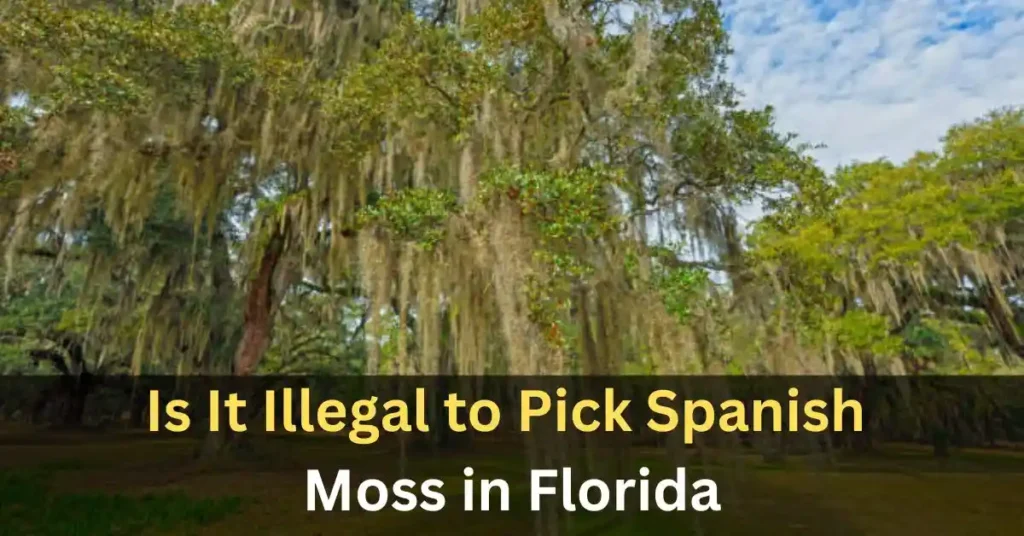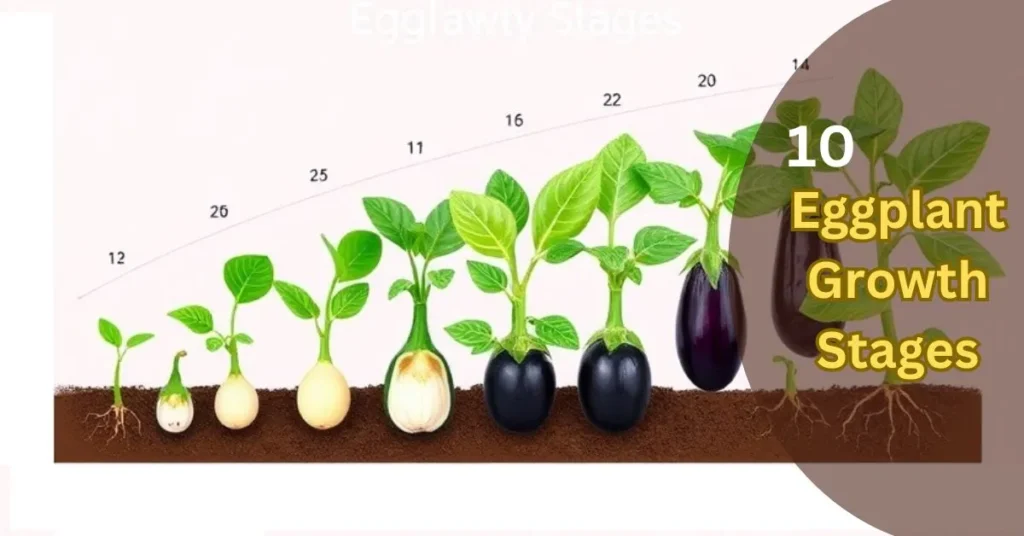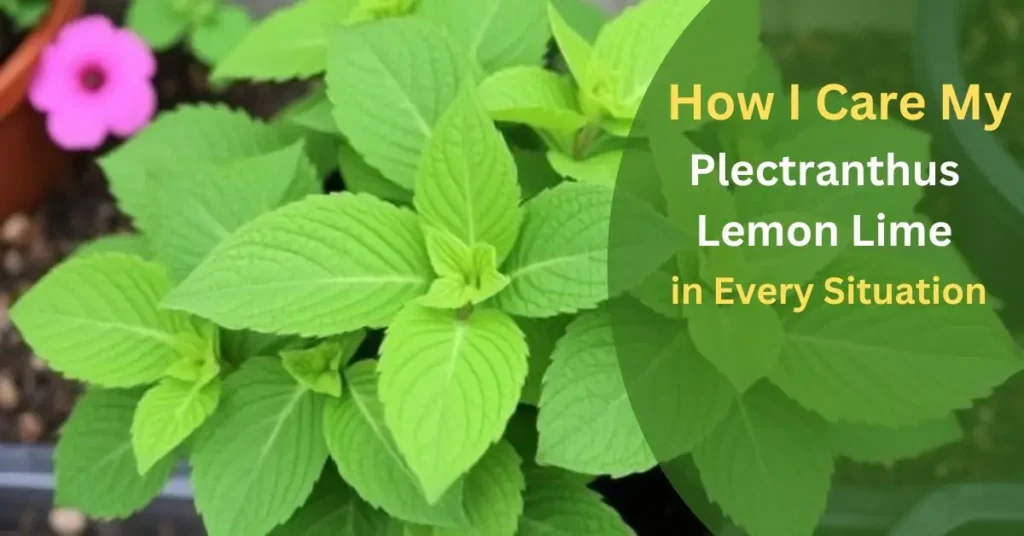Walking under the wispy, grayish-green strands of Spanish moss draping from tree branches feels like stepping into a scene of southern magic. This iconic plant, often tied to the mystique and ambiance of the American South, creates an almost ethereal and sometimes spooky effect.
While its strong identification with southern landscapes might make you wonder, “Can I legally pick it off the trees in Florida or simply gather it from the ground?” the answer lies in understanding the legalities of its collection.
This comprehensive guide aims to examine whether harvesting this epiphyte is allowed. Before rushing to collect Spanish moss for yourself, it’s essential to know its many purposes, such as use in crafts, mulch, or other projects, while avoiding running afoul of the law.
Always consider where and how you plan to use the moss. Picking directly from private or protected areas without permission could lead to trouble, but gathering fallen strands from accessible public areas might be permissible.
Key Points
| #- | Aspect | Details |
|---|---|---|
| 1- | Scientific Name | Tillandsia usneoides |
| 2- | Family | Bromeliad (related to pineapples) |
| 3- | Habitat | Found on trees like live oaks and cypress in humid areas such as swamps and coastal regions. |
| 4- | Legality | Generally legal to collect, except in protected areas like state and national parks. |
| 5- | Protected Areas | Harvesting prohibited in parks, preserves, and wildlife refuges. |
| 6- | Private Property | Requires explicit permission from the landowner before collecting. |
| 7- | Commercial Harvesting | Requires permits and approval from the Florida Department of Agriculture. |
| 9- | Environmental Role | Provides habitat for birds, bats, and insects; helps reduce noise pollution. |
| 10- | Historical Uses | Used for insulation, mattress stuffing, pottery reinforcement, and evaporative cooling. |
| 11- | Modern Uses | Popular in crafts, floral arrangements, mulch, and biodegradable packing material. |
| 12- | Harvesting Tips | Collect fallen moss; avoid stripping live trees or damaging them. |
| 13- | Chigger Warning | Spanish moss may contain chiggers, so handle with caution. |
| 14- | Cultural Significance | Associated with southern heritage, used by Native Americans for crafts and medicine. |
| 15 | Key Locations in Florida | Common in humid regions across the state, particularly on oaks and cypress trees. |
What Exactly is Spanish Moss?
Have you ever seen those threadlike strands of grey and silver hanging from trees in the southeastern United States? That’s Spanish moss. Known scientifically as Tillandsia usneoides, it’s a unique flowering plant in the bromeliad family, which is surprisingly related to pineapples.
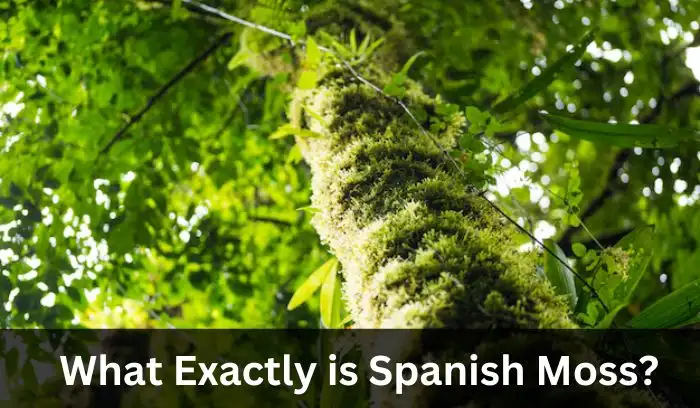
Unlike most plants, it doesn’t rely on soil for survival. Instead, it absorbs nutrients, water, and even moisture from the air and rainfall. You’ll often find it clinging to trees, fences, and even power lines, but it doesn’t harm its host. It’s not a parasite or a pest, just an incredible example of nature’s adaptability.
Originally native to Central America and Mexico, Spanish moss thrives in the warm and humid climates of the coastal states, stretching from Texas to Virginia. With its tiny spikes and microscopic seeds, it reproduces effortlessly, growing strands that can reach up to 20 feet long. Whether draped over ancient oaks or swaying gently in the breeze, it’s a striking feature of the southern landscape, particularly in places like Florida.
Is Spanish Moss Protected in Florida?
In Florida, Spanish moss is not classified as a protected plant. There are no statewide laws that prohibit the harvest or collection of Spanish moss when it’s growing in the wild.
This makes it legal to pick and gather the moss for various purposes, such as craft projects, wedding decor, or even landscaping. If you desire to use it, you can easily do so without facing legal restrictions. However, it’s important to stay aware of some caveats and regulations that may apply.
For example, while it’s generally fine to collect Spanish moss in many areas, some places may have their own specific rules regarding applications or other uses. Always check local regulations before you gather, especially for large collections or if you’re working with it for commercial purposes.
Location matters
When it comes to Spanish moss, the location where it is growing really matters. In certain places like state and national parks, wildlife preserves, and protected public lands, harvesting or collecting Spanish moss is not allowed.
These areas are designated as protected to preserve the local ecosystem and its natural beauty. However, collection is permitted in unregulated areas or on private property, where harvesting can be done without restrictions. It’s important to always be aware of where you’re gathering Spanish moss to avoid breaking any rules.
Get permission
When dealing with Spanish moss, it is important to always get explicit consent from the landowner before removing moss from private trees. In Florida, although Spanish moss is not protected by law, it’s still necessary to respect property boundaries.
Trespassing is not only illegal but can lead to misunderstandings. Be sure to ask the landowner for permission before gathering moss, even if it’s on private property. This shows respect for the environment and the rights of others.
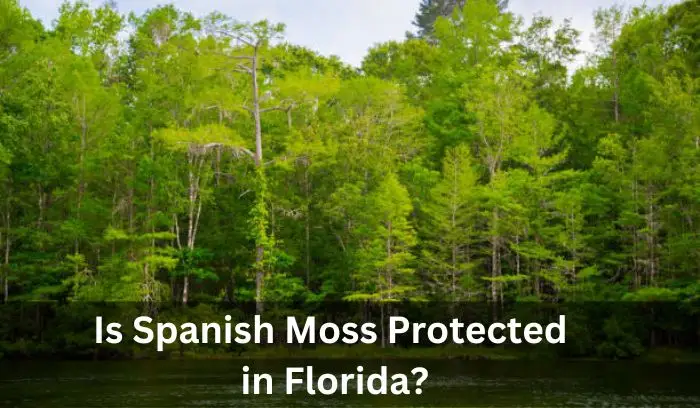
In my experience, clear communication with the landowner goes a long way in ensuring that everyone stays on the same page. Whether you’re using Spanish moss for craft projects or other purposes, getting permission first is the right step to avoid any issues down the road.
No damaging trees
When removing Spanish moss, it’s important to be aware that it is illegal to damage or disfigure any public or private trees. Whether you’re working on your own property or elsewhere, always exercise care when handling moss.
Make sure to avoid causing any harm to the tree’s bark, branches, or leaves, as this can negatively affect the tree’s health. Respect for nature and following the law is essential when dealing with Spanish moss in Florida.
No commercial harvesting
In Florida, Spanish moss cannot be harvested on a large-scale without special approval and permitting from the Florida Department of Agriculture. This is to ensure that commercial harvesting does not harm the environment or disrupt the local ecosystem.
However, casual gathering for personal use is allowed, as long as it is done in moderation. It’s important to remember that any commercial harvesting requires a thorough process of obtaining the proper approval and permitting, making it a regulated activity in the state.
If you’re thinking of harvesting Spanish moss, make sure you’re aware of the guidelines and know whether your intentions fall under casual gathering or require special permits.
Responsible Harvesting Tips
When harvesting Spanish moss, always be mindful of the impact on the environment. It’s essential to collect only the loose strands that have fallen naturally to the ground after storms or winds.
Never strip moss directly from the trees, especially from the smaller and younger ones, as they cannot afford the loss. Instead, focus on harvesting moss from larger, mature trees. By taking only small quantities from a wide area, you can avoid excessive gathering from any one location.
Sustainability is key in preserving the moss population for future generations. Leaving some strands behind helps to regenerate the population, ensuring it thrives in the long run.
It’s also important to remember that bromeliads, native to areas like Florida, play a role in the conservation of abundant plants like Spanish moss. By being mindful, you contribute to the well-being of the species and help maintain balance in the ecosystem.
Using Collected Spanish Moss
Spanish moss is a versatile green material that can be used for a variety of sustainable purposes. Once harvested, it makes an excellent craft material, often used in decor like wreaths, arbors, and hanging baskets. For arts and crafts, it serves as a great basis for making dolls, baskets, and other creations.

As mulch in landscaping, it works well as a natural mulch and ground cover, helping retain moisture and control weeds. It also serves as a packing material, offering a biodegradable substitute for Styrofoam, and can be used for pillow stuffing due to its natural fiber.
If you plan to use Spanish moss in any of these ways, it’s important to ensure it’s dried thoroughly to avoid rot. Hang it in open airy bundles until it becomes crisp. For preservation, you can use a glycerin solution to maintain its longevity. Spanish moss is a beloved plant in Florida, and when used with care, it can be a lasting addition to your projects.
Just remember to follow regulations and ensure harvesting is done responsibly, limiting it to personal use and respecting protected areas to avoid commercial exploitation. The careful practice of sound harvesting practices helps maintain the populations of this iconic southern plant.
Uses For Spanish Moss
Spanish moss has many uses, both practical and decorative. People gather it to stuff items like car seats, furniture, and mattresses for insulation. It was once widely used in homes for this purpose, but nowadays it’s more common for making flower arrangements or serving as mulch in gardens.
Interestingly, wildlife also benefits from Spanish moss. Birds of prey build their nests using it, while bats, reptiles, and amphibians find shelter in clumps of moss.
However, be cautious when handling Spanish moss, as it may contain chiggers, which can cause an itch when you touch it. Despite that, its versatility makes it a useful and natural material for various needs.
Spanish Moss and Tree Damage
Many homeowners believe that Spanish moss can kill their trees, but this is a misunderstanding. Spanish moss is not parasitic, and the only thing it needs from trees is support. When trees experience a falling or infestation of moss, the cause is usually something else.
A tree’s canopy may thin as it dies, allowing more sunlight to reach the tree, which can, in turn, help the Spanish moss to grow. While it may slow the growth of trees, healthy trees can grow faster than the moss, so the effect is minimal.
Sometimes, the weight of Spanish moss can weigh down branches and even break them. If you want to remove the moss, it’s best to call an arborist who can take it off by hand. The moss may grow back eventually, but the trees themselves will continue to thrive as long as they are healthy and properly cared for.
Environmental Importance of Spanish Moss
Spanish moss (Tillandsia usneoides) plays a crucial role in the environment, providing habitat for various animals. It is especially important for birds like the yellow-throated warbler, northern parula, and Baltimore oriole, as they use it for nesting.
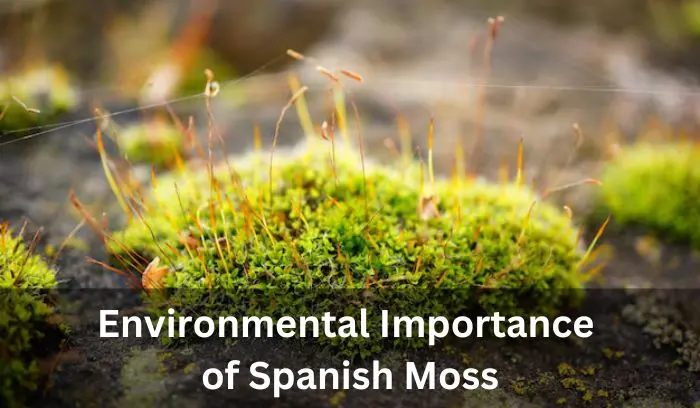
Bats, including the Seminole bat, also rely on Spanish moss for roosting during the day. The plant offers cover for insects, small animals, and even species like a spider. Additionally, zebra longwing butterflies, Florida’s state butterfly, find a safe place to rest in Spanish moss at night.
Apart from providing shelter, Spanish moss helps reduce noise pollution through its dense, tangled structure, which breaks up sound waves, minimizing echo and reverberation.
The ecological value of Spanish moss extends beyond wildlife. It contributes to the Florida ecology, benefiting both wildlife and humans. Spanish moss is often found in clumps and is used in various commercial uses like floral arrangements, mulch, packing material, insulation, and even as mattress stuffing and automobile seats. Historically, it has been put to practical use in homes and industries, proving its versatility.
Cultural and Historical Significance of Spanish Moss
A Symbol of Heritage and Tradition
Spanish moss holds profound cultural significance, representing the rich heritage of the Lowcountry for centuries. Its uses span from building material to inspiration in arts, deeply intertwining it with the history of the region.
Native American communities utilized Spanish moss innovatively, crafting bedding and providing insulation in their homes. They also used it medicinally to treat rheumatism, diabetes, and fevers. Its role in folklore is equally compelling, as the tale of Gorez Goz and his fateful beard entangled in a tree highlights its mythical charm.
Itla-okla, the Native name meaning “tree hair,” along with the French term Barbe Espagnol (“Spanish Beard”) and the Spanish term Cabello Francés (“French Hair”), further underline its cultural identity.
Historical Uses and Practical Innovation
Over 3,000 years, Spanish moss has proven indispensable. Early societies incorporated it into fire-tempered pottery, enhancing durability. By the early 1900s, it was widely used in mattresses, cushions, saddles, and car seats due to its resilience.
In the southwestern United States, dried moss was even used to create evaporative coolers, providing relief in the arid desert regions. This enduring plant bridges the past and present, symbolizing adaptability and ingenuity across United States history.
Where to Find Spanish Moss in Florida
In Florida, Spanish moss can be seen hanging from trees in various areas with high humidity, such as swamps, rivers, and along the coast. The live oak and cypress trees are where it’s most commonly found, but it also grows on other trees and plants. This bromeliad, though not a moss or a lichen, thrives in the warm, humid conditions across the state.
As a perennial herb in the pineapple family, Spanish moss is an epiphyte, meaning it grows on other plants without stealing nutrients, so it’s not parasitic and doesn’t harm the host tree. Whether you’re exploring local parks or wandering through natural spaces, keep an eye out for this unique plant.
If you’re in Port Orange or other parts of Florida, visiting parks like Live Oaks Park or even Buschman Park can give you the chance to observe Spanish moss draped over southern oak trees.
While it’s easy to remove Spanish moss by hand, especially on small trees, for larger areas or trees, it’s best to consult an ISA certified arborist before using chemical treatments. This ensures the process is done safely without causing damage to your trees.
FAQs
Spanish moss can sometimes grow heavily on trees, causing them to weigh down and break branches. While it may shade the leaves and slow growth, healthy trees can often outgrow it. To remove it, it’s best to have an arborist do it by hand. Keep in mind that Spanish moss will likely grow back after a while.
While Spanish moss may look beautiful as it hangs in gray strands, swaying in the gentle breeze, it’s important to be cautious. Touching it is actually a bad idea because it can carry chiggers or Spanish Moss lice. These tiny pests can cause itchy red bumps on your skin, making the experience much less pleasant than it appears. It’s always a good idea to enjoy the sight of this unique plant from a distance rather than getting too close or touching it.
If you’re looking to get rid of Spanish moss, one of the most effective methods is using copper sulfate. While it’s considered a reliable solution, it’s also the slowest in terms of seeing results. This treatment works by targeting the moss and helping in removing it from the trees, though it may take some time to fully clear it away. The gradual process means that while you will eventually see results, it’s not an instant fix.
Collecting air plants in Florida is illegal without proper permits and permission. There are strict laws that regulate how you can collect, manipulate, and release these plants. To do so, you must follow specific methods for conservation work to ensure their protection. Always check local regulations before collecting air plants.
Final Thoughts
Spanish moss, a quintessential symbol of Florida’s natural and cultural heritage, is a versatile and fascinating plant. While harvesting it for personal use is generally allowed, always follow local regulations, respect private property, and prioritize sustainability. By doing so, you help preserve this iconic feature of the southern landscape for future generations to appreciate and enjoy.
See Also:
Why Are Seeds Popping Out of the Soil When Worms Fertilize?
When to Seed Lemongrass in Zone 9a? A Complete Guide

